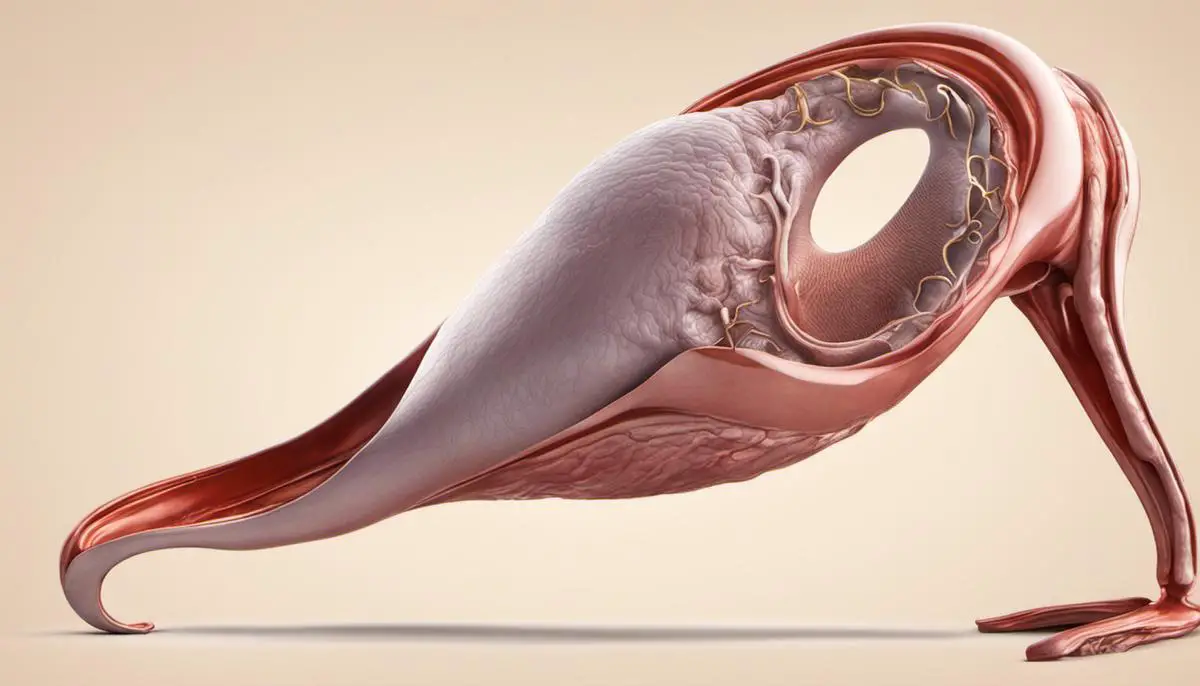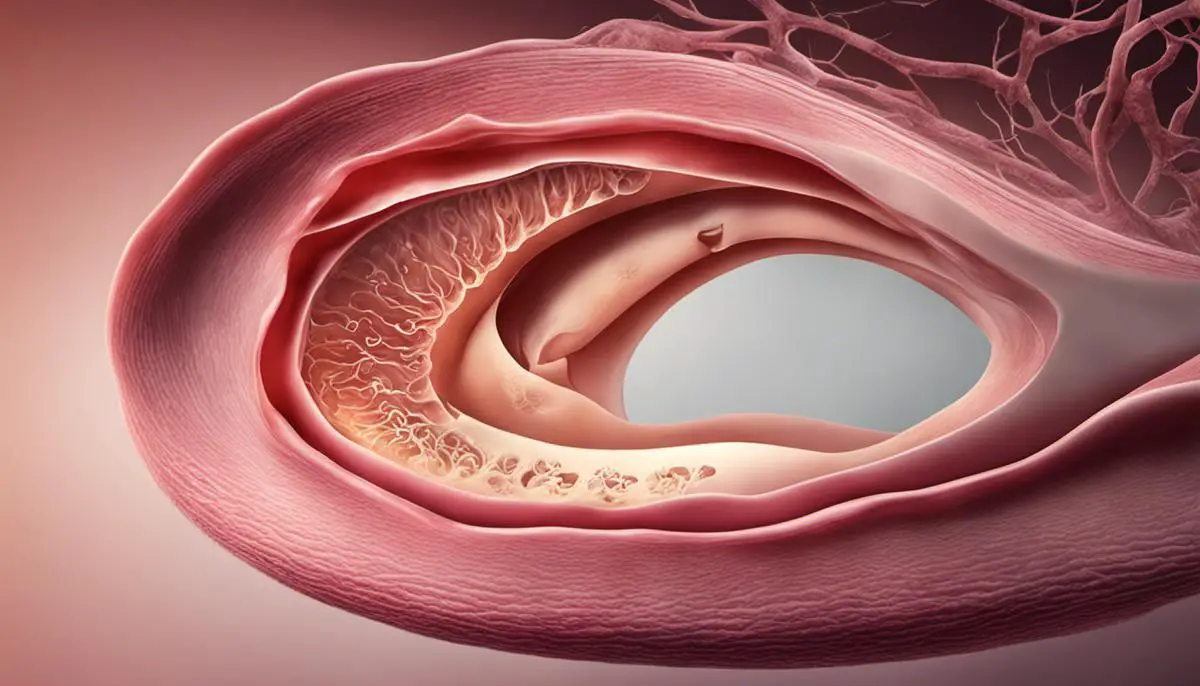A woman’s reproductive system is an intricate network of organs, each playing a crucial role in the reproduction process. One such organ, the uterus, is typically positioned in a straight, upright manner. However, in some women, it may deviate from its expected location and tilt backwards, a condition known as a ‘retroverted uterus’. Rather than being a cause for alarm, it is important to understand that this condition is merely one of several anatomical variations. Despite its prevalence, much confusion and misunderstanding surround the topic, particularly relating to its potential effects on pregnancy. This article aims to unravel the complexities of a retroverted uterus, focusing on its symptoms, the impact on pregnancy, management techniques, and professional medical opinions.
Understanding the Retroverted Uterus
Understanding the Retroverted Uterus
The uterus, a pear-shaped organ located in the female pelvic region, primarily functions in the reproductive process. It hosts a developing fetus during pregnancy, and its orientation within the body contributes significantly to its functioning. Generally, the uterus is positioned in an anteverted position where it tilts forward towards the navel. However, in 20-30% of women, the uterus is in a retroverted position. A retroverted uterus, also known as a tilted or tipped uterus, is a naturally occurring variation in the female anatomy where the uterus tilts back towards the spine.
It’s crucial to note that a retroverted uterus is seen as a anatomical variant rather than a medical condition. For most women, it’s something they’re born with, but for some, it can occur as a result of childbirth, menopause or pelvic surgery, when ligaments holding the uterus in place become lax. It is often asymptomatic and thus, it generally goes unnoticed unless it’s discovered during a routine examination.
Understanding the Retroverted Uterus and Potential Pregnancy Complications
A retroverted uterus, although relatively common, typically does not create significant issues or complications during pregnancy. In the early stages, the uterus is small enough that its tilt doesn’t cause problems. Over the course of pregnancy, it usually grows and naturally orientates upwards and forwards, irrespective of its previous position.
Rarely though, a retroverted uterus can cause some troubles. These may include lower back pain in early pregnancy and urination difficulties. The condition can also make manual pregnancy testing and the insertion of intrauterine devices a little more tricky.
Some research has suggested possible links between a retroverted uterus and an increased risk of miscarriage. More specifically, an extremely rare condition known as an incarcerated uterus, where the uterus becomes stuck in the pelvic cavity, might pose risks for both the mother and baby. This happens in about 1 in every 3,000 pregnancies.
If a woman is diagnosed with an incarcerated uterus, a healthcare professional might try to manually realign the uterus using a procedure called uterine manipulation. If the manual adjustment is not successful for some reason, it may be necessary to resort to surgical intervention.
In summary, despite a retroverted uterus usually being symptomless and not causing complications in pregnancy, it can slightly heighten certain risks. Regular prenatal check-ups can ensure the early detection and prompt treatment of any potential issues. It’s crucial for women to maintain open lines of communication with their healthcare providers about concerns related to pregnancy and reproductive health.

Symptoms and Diagnosis of Retroverted Uterus
Recognizing the Symptoms of a Retroverted Uterus
A retroverted uterus often doesn’t present any noticeable symptoms. However, some women may experience certain discomforts such as pain during intercourse or menstrual irregularities. This condition is also associated with lower back pain, recurrent urinary tract infections, and trouble with tampon use. It’s important to note that these symptoms are not exclusively linked to a retroverted uterus and could be indicative of other conditions.
Risk of Pregnancy Complications
In terms of pregnancy, a retroverted uterus can sometimes complicate the process, but it mostly doesn’t pose significant problems. In the early stages of pregnancy, a retroverted uterus can cause back pain, an increased frequency of urination, and possibly an increased risk of miscarriage. A more severe complication is an incarcerated uterus, where the uterus becomes trapped in the pelvic cavity. This situation is quite rare, occurring in 1 in 3,000 pregnancies and usually resolves itself naturally by the 10- to 16-week mark as the uterus grows and moves into a more vertical position.
Diagnosis of Retroverted Uterus
To diagnose a retroverted uterus, a medical professional typically performs a physical examination, often during a routine pelvic exam. They may also use imaging tests like an ultrasound to get a visual representation of the uterus position. In some cases, a doctor may utilize a hysterosalpingogram, a special type of X-ray used to examine the uterus and fallopian tubes.
Medical Professionals Involved
The professionals who usually facilitate the diagnosis are general practice doctors, gynecologists, or obstetricians specializing in female reproductive health. They are trained to recognize the symptoms and perform the necessary examinations and tests to confirm if a woman has a retroverted uterus.
In summary, having a retroverted uterus may lead to some level of discomfort and potential minor complications throughout pregnancy, but it typically isn’t a significant issue. That said, should symptoms persistently occur or worsen, it is crucial to seek medical advice. Regular monitoring is advisable for pregnant women with a retroverted uterus to promptly address any complications, even though they occur infrequently.

Retroverted Uterus and Its Effects on Pregnancy
Understanding Retroverted Uterus
Retroverted Uterus, alternately referred to as a tipped or tilted uterus, indicates a scenario where the uterus inclines backward at the cervix instead of leaning forward. This configuration is a commonplace anatomical variation that affects around 20 to 30 percent of women. Under normal circumstances, it does not interfere with the uterus’s function or result in any health-related issues.
Retroverted Uterus and Pregnancy
During early pregnancy, the uterus is more an organ suspended in the pelvic cavity than one firmly fixed in place. Whether a uterus is anteverted (leaning forward) or retroverted (leaning backward) tends not to matter much, as it’s surrounded by a supportive network of ligaments. As a pregnancy progresses, the expanding uterus typically elevates out of the pelvis and, in doing so, assumes a more “typical” position whether or not it was retroverted to begin with.
Effects on Pregnancy Symptoms
A retroverted uterus can cause discomfort in the early stages of pregnancy. As the uterus grows, it’s more likely to tilt forward and reduce symptoms. However, some women may experience back pain or urinary issues, like frequent urinary tract infections, due to the uterus pressing against the rectum and bladder.
Retroverted Uterus and Pregnancy Complications
The majority of women with a retroverted uterus have a normal pregnancy and delivery. However, in some rare cases, this condition may increase the risk of complications. The most notable is a condition called ‘incarcerated uterus’. This occurs when the uterus becomes trapped in the pelvis, rather than rising into the abdominal cavity as it grows. This is a very rare condition and can cause symptoms like pelvic pain, difficulty urinating, and constipation. However, it’s important to note that the majority of women with a retroverted uterus won’t experience this complication.
Retroverted Uterus and Labor
Typically, a retroverted uterus doesn’t interfere with labor or delivery. By the time a woman is ready to give birth, the uterus has stretched and grown and usually oriented itself in a way conducive to childbirth. There are no noted connections between a retroverted uterus and the need for a C-section, or other labor complications.
Monitoring and Management
Since a retroverted uterus can sometimes be associated with other conditions like endometriosis and pelvic inflammatory disease, it’s important for healthcare providers to monitor for symptoms of these issues. For most women, there aren’t any specific adjustments or steps that should be taken during pregnancy just because of a retroverted uterus. As with any pregnancy, regular prenatal care is key for monitoring the progress of the pregnancy and the health of the baby.
In the rare cases where a retroverted uterus is causing symptoms or complications, treatment may be needed. There are pelvic exercises that may help correct this condition, and in some cases, a medical procedure might be necessary. That said, such measures are rarely required.
Keep in mind that having a retroverted uterus is a common, normal variant of uterine position that generally doesn’t lead to any complications. However, if you feel unusual discomfort or have any concerns related to it, it’s essential to consult with a healthcare professional for advice.

How to Manage Pregnancy with a Retroverted Uterus
What is a Retroverted Uterus?
A retroverted uterus, also commonly known as a tilted or tipped uterus, is a typical anatomic condition where the uterus tilts backwards, pointing more towards the rectum rather than frontwards towards the belly. This condition is quite commonplace, with research suggesting that between 20-25% of women have a retroverted uterus. Most women with this condition are born with it implying it’s congenital. However, certain experiences or health issues such as pregnancy, menopause, endometriosis, and pelvic inflammatory disease can also lead to a uterus becoming retroverted.
Retroverted Uterus and Pregnancy
Despite being a common condition, a retroverted uterus is often a topic of concern for expecting mothers, mainly due to the misinformation and myths surrounding its impact on pregnancy. It is important to understand that a retroverted uterus does not necessarily lead to complications in pregnancy or childbirth. In most cases, the growing uterus adjusts itself during pregnancy, around the 10th to 12th week, and assumes the typical forward-tilting position.
Potential Complications
There can be potential complications, but they are rare. Difficulties may arise in cases where the uterus does not self-correct its position. This can lead to a condition called incarcerated uterus, where the growing uterus becomes trapped in the pelvic area, causing symptoms like pain, urinary issues, and constipation. Additionally, some studies suggest that a retroverted uterus may increase the risk of miscarriage in the first trimester. However, the evidence for this potential risk is limited, and generally, most women with a retroverted uterus have normal pregnancies.
Managing Pregnancy with a Retroverted Uterus
Those experiencing discomfort due to a retroverted uterus during pregnancy can manage it through a variety of measures. Gentle exercises such as pelvic tilts or knee-to-chest exercises can help to alleviate the discomfort associated with it. Regularly performing these exercises can even cause the uterus to move into a more comfortable position over time.
Prenatal yoga and gentle stretches are also beneficial for maintaining flexibility, relieving discomfort, and promoting overall well-being during pregnancy. However, any exercise regimen should be undertaken only after consultation with a healthcare provider.
Precautions and Regular Check-ups
Regular prenatal care is crucial for all pregnancies but becomes even more important in cases of a retroverted uterus. Healthcare providers can monitor the position of the uterus and identify any potential issues early on. In the rare case that the tilted uterus does not correct itself and leads to complications, physicians can perform a simple, non-surgical procedure to manually reposition the uterus.
Final Thoughts
Understanding that a retroverted uterus, while a common variation in women, doesn’t automatically mean a higher risk of pregnancy complications is crucial. With correct care, frequent medical consultations, and a balanced lifestyle, this condition can be effectively controlled, supporting a smooth and complication-free pregnancy journey.

Professional Opinions on Retroverted Uterus & Pregnancy
Familiarizing Yourself with Retroverted Uterus
Commonly known as a tipped or tilted uterus, a retroverted uterus is a natural variation in the orientation of a woman’s uterus. Instead of tilting towards the belly, such a uterus leans in the direction of the spine. This condition impacts around 20-30% of women and can be either congenital, meaning it exists at birth, or acquired due to factors like pregnancy, menopause, or pelvic surgeries.
Retroverted Uterus and Pregnancy
Generally, having a retroverted uterus does not negatively influence fertility or pregnancy. Many women with a retroverted uterus experience uncomplicated pregnancies and childbirth. During the early stages of pregnancy, the uterus is small and the position does not matter much. As pregnancy advances, the growing uterus usually adjusts itself into a more standard position.
However, in rare cases, a retroverted uterus can lead to complications. For a small number of women, the uterus does not correct its position and this is known as an incarcerated uterus. It can cause symptoms such as pain, urinary issues, and constipation.
Medical Opinions on Retroverted Uterus and Pregnancy
Various studies and medical opinions show no strong connection between a retroverted uterus and difficulty in getting pregnant, miscarriage, premature birth, or birth defects. The American Pregnancy Association also supports this stance that a tipped uterus does not contribute to complications during pregnancy or labor.
However, some healthcare professionals have observed that a retroverted uterus may cause some discomfort or pain during sexual intercourse and might lead to difficulties during manual examinations or ultrasound scanning due to its positioning.
Moreover, some research suggests that women with a retroverted uterus are more likely to experience back pain during pregnancy, especially in the first trimester. They may also be at more risk of developing urinary tract infections.
Managing Complications Related to Retroverted Uterus
In cases where a retroverted uterus leads to complications or persistent pain, medical interventions may be required. Pelvic physiotherapy is often recommended to help manage pain and discomfort. In severe cases, a procedure called a uterine suspension may be suggested to reposition the uterus. This is typically performed laparoscopically and has a high success rate.
Pregnant women with a retroverted uterus should have their condition closely monitored by healthcare providers. In some cases, the expectant mother may require more frequent ultrasounds or check-ups to ensure the uterus is growing and moving as expected.
In conclusion, although a retroverted uterus can occasionally lead to complications during pregnancy, it is generally not considered to be a significant risk factor. Efforts should be made to monitor and treat any symptoms or complications should they arise to ensure a healthy pregnancy and childbirth.

Through comprehensive understanding and proper management, a retroverted uterus need not be a source of undue concern for prospective mothers. Indeed, a retroverted uterus may pose unique challenges during pregnancy, and in rare instances, cause complications. However, knowledge is power. By equipping oneself with an awareness of symptoms, understanding potential changes during pregnancy, and adopting recommended exercises and precautions, women can navigate a pregnancy with a retroverted uterus in a confident and informed manner. The importance of seeking medical advice cannot be understated given the varying professional viewpoints on this topic. Remember, every woman’s body and every pregnancy is unique – embracing this uniqueness is a step towards a healthy, safe, and fulfilling pregnancy journey.
